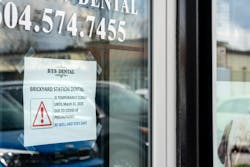Dental office COVID-19 shutdown—its effect on RDHs
Beginning in March, RDH has kept you informed of the ever-changing COVID-19 news, providing updates through RDH eVillage, DentistryIQ, and on the RDH website. To understand your challenges and hear your voice, RDH recently conducted a survey of our readers pertaining to the closing of dental offices, the effect on the dental hygienist’s lifestyle, and the concerns of reopening the dental office doors.
You were ready to share your thoughts and we received over 2,200 responses, with about 75% of the replies coming in the first 24 hours. The results provided a well-rounded summary as there was a distribution of locations from urban to rural, with most responses reflective of suburban regions.
Finances
Some of the survey results were surprising but the majority are a confirmation of what you have been sharing with us through emails and article submissions. When asked about your work situations and financial status the responses were as follows.
- 97% of dental offices were currently closed or providing emergency care only
- 82% of RDHs have applied for unemployment
- 22% of RDHs are using their savings
- 6% are receiving partial or full salaries while offices are closed
- 28% are the sole provider for themselves and/or family
- 55% have another provider in the family who is still working
The open-ended question which followed this segment provided insight into how challenging these times are for so many dental hygienists. Several have no source of income and many are thankful their spouse/partner is still working. Those in academia or working for hospitals are still employed, though the stress is high for educators trying to determine how to manage dental hygiene education online. Many are evaluating new options for advancing their careers or evaluating changing professions completely.
Staff anxiety about reopening the practice
As time is moving forward, we are learning more about the virus and we progress into the recovery phase of the pandemic, we asked several questions regarding preparing for the reopening of offices and the return of patients into your operatory. Are you prepared, is the office prepared, and what are the greatest fears?
- 35% stated the office has started building a strategic plan for reopening
- 61% were unaware if their office had begun to build a plan, as there was no communication
- 26% were concerned about not having enough patients
- 31% were anxious of being asked to provide care in situation they are not comfortable in
- 44% were afraid of inadequate infection control standards
These responses are reflective of how open communication between an office and the staff may alleviate employee anxiety, and a strong plan may be beneficial in comforting not only staff but also the patients as they return to the office. Anxiety is high as answers and standards are slow to be defined and determined. The guidelines from the Centers for Disease Control and Prevention are comforting, though there are still so many questions and we are still waiting to hear the solutions on how to manage aerosols, the one element a dental hygienist knows is the most concerning for us as health-care providers working eight hours a day in the mouth.
Infection control changes
The majority of RDH are very aware of proper personal protective equipment (PPE) and the infection control standards of a dental office. We have studied proper guidelines for years. Many of us attend courses and programs to maintain the highest of standards in our operatories. The current knowledge we have of the novel coronavirus will change the traditional infection control standards, but answers or solid direction have not been determined.
- 69% believe infection control practices in the office will change, with the driving force for those changes being made by the dentist (39.4%) and the dental hygienist (39.95%)
- 28% believe the guidelines will stay the same
Communication with patients
Throughout the past several weeks there have been numerus discussions as to active communication between the dental offices and the patients. Are the patients being contacted about why offices are closed? What are the challenges and how will the office respond to these challenges and what may be different the next time the patient walks into your office? It has been shared that open communication with the patients may limit the fear and bring more patients back into the office once the doors open.
- 55% said the patients were not being communicated with about changes in the office but you felt they should
- 30% were in communication with patients about changes within the office
Your comments
The survey results were a confirmation of what many of us suspected, and a couple were eye-opening. We did include two open-ended questions and the responses have been the most personable and moving. Comments ranged from “no income” to “I have good savings.” Many of our colleagues are struggling through these times, as is our society. Some have become very innovative, working at COVID-19 testing centers or as pharmaceutical assistants. Some own their own practices and are embracing teledentistry assessments for emergency care only.
So many RDHs also described using the time to advance their knowledge through CE programs. At the same time, there is a tremendous amount of fear of the unknown:
- Alternative work options for RDH
- Defining the necessity of longer appointment times and the financial profits on such appointments
- New instrument costs versus advanced filtering systems to manage aerosols
- Staying positive and taking CE and getting back in shape
The comments, the amount of knowledge shared, the emotion and personal passion you communicated are inspiring. The strength behind these responses leads this hygienist to believe we will see positive changes in our professional future. Thank you for taking the time to share your challenges.
Jackie Sanders, MBA, RDH, has over four decades of continual career development and experience in dentistry. As the chief editor of RDH magazine, she strives to remain a proactive personality in the continual advancement of the profession. She has been defined as a motivated trendsetter and dependable colleague and is inspired by her true passion of helping others to achieve their personal goals. Her personal commitments: “it’s important to be happy, be a positive influence, and make a difference.”
About the Author

Jackie Sanders, MBA, RDH
Chief Editor, RDH magazine
Jackie Sanders, MBA, RDH, has over four decades of continual career development and experience in dentistry. As the chief editor of RDH magazine, she strives to remain a proactive personality in the continual advancement of the profession. She has been defined as a motivated trendsetter and dependable colleague and is inspired by her true passion of helping others to achieve their personal goals.
